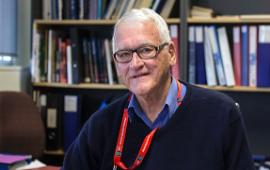Professor Tom Spurling awarded ANZAAS Medal for scientific achievement

In Summary
- Professor Tom Spurling awarded 2017 ANZAAS Medal for scientific achievement
- He has extensive experience in managing the process of translating research into commercial products
Swinburne’s Professor of Innovation Studies, Tom Spurling AM, has been awarded the prestigious 2017 Australian and New Zealand Association for the Advancement of Science (ANZAAS) Medal.
The award recognises Professor Spurling’s contribution to the advancement of science over the past 55 years.
Most notably acknowledged for his role in the development and commercialisation of plastic banknotes, Professor Spurling is widely regarded as an expert in the commercialisation of research.
His extensive experience in managing the process of translating research into commercial products includes breakthroughs such as the 30-day contact lens and the MIEX water purification process.
Professor Spurling now works at the Centre for Transformative Innovation at Swinburne and he has written extensively on science, technology and innovation policy and practice.
A qualified physical chemist, Professor Spurling began his research career in 1961 – a time he describes as one of great trust in science.
“On the whole, politicians did not question the advice that scientists gave them,” Professor Spurling says of his early years.
“The public was convinced that investing in research and education was a key to future prosperity.
“We live in a different time now. Scientific evidence is just one of the factors taken into account when governments make decisions.
“In 1961, we did not have to argue for the validity of scientific evidence: we do now.”
For many years Professor Spurling worked as a research scientist and then at an executive level within the CSIRO.
During his time at the CSIRO he worked with Professor David Solomon on the development of polymer banknotes, providing statistical methods for validating tests, devising psycho-physical experiments to understand ‘the feel of a banknote’, and helping to develop optical variable devices.
First introduced in Australia in 1988, plastic banknote technology is now used in more than 30 countries. Professors Spurling and Solomon published a book about the development of this technology in 2014.
Since 2002 Professor Spurling has been employed at Swinburne, first as the Director of the Industrial Research Institute, then as Dean of the Faculty of Engineering and Industrial Sciences until he took up the position of Chief Executive of the CRC for Wood Innovations, which ended in 2008.
His current research interests include the use of social network analysis in understanding how best to commercialise public sector research, the use of economic analysis to understand why some firms invest in innovation, and the use of case studies to tell the story of Australian innovation.
Professor Spurling will receive the medal at the Gene Technology Access Centre as part of National Science Week celebrations on Wednesday 16 August.
The ANZAAS Medal is awarded annually for services for the advancement of science or administration and organisation of scientific activities, or the teaching of science throughout Australia and New Zealand and in contributions to science which lie beyond normal professional activities.

